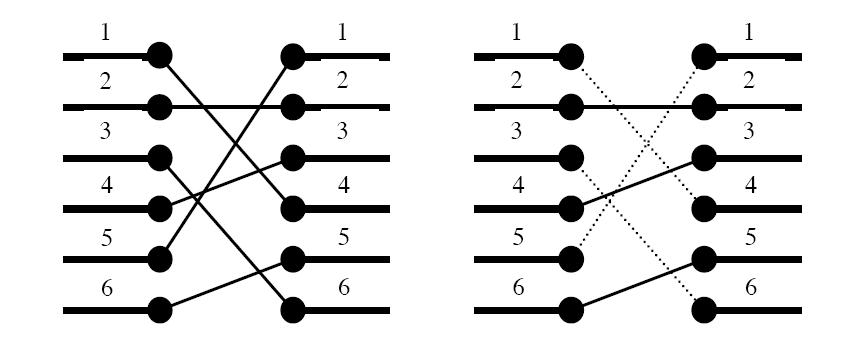C - Bridging signals
C - Bridging signals
'Oh no, they've done it again', cries the chief designer at the Waferland chip factory. Once more the routing designers have screwed up completely, making the signals on the chip connecting the ports of two functional blocks cross each other all over the place. At this late stage of the process, it is too
expensive to redo the routing. Instead, the engineers have to bridge the signals, using the third dimension, so that no two signals cross. However, bridging is a complicated operation, and thus it is desirable to bridge as few signals as possible. The call for a computer program that finds the maximum number of signals which may be connected on the silicon surface without rossing each other, is imminent. Bearing in mind that there may be housands of signal ports at the boundary of a functional block, the problem asks quite a lot of the programmer. Are you up to the task?
Figure 1. To the left: The two blocks' ports and their signal mapping (4,2,6,3,1,5). To the right: At most three signals may be routed on the silicon surface without crossing each other. The dashed signals must be bridged.
A typical situation is schematically depicted in figure 1. The ports of the two functional blocks are numbered from 1 to p, from top to bottom. The signal mapping is described by a permutation of the numbers 1 to p in the form of a list of p unique numbers in the range 1 to p, in which the i:th number pecifies which port on the right side should be connected to the i:th port on the left side.
Two signals cross if and only if the straight lines connecting the two ports of each pair do.
Input
On the first line of the input, there is a single positive integer n, telling the number of test scenarios to follow. Each test scenario begins with a line containing a single positive integer p<40000, the number of ports on the two functional blocks. Then follow p lines, describing the signal mapping: On the i:th line is the port number of the block on the right side which should be connected to the i:th port of the block on the left side.
Output
For each test scenario, output one line containing the maximum number of signals which may be routed on the silicon surface without crossing each other.
Sample Input
4 6 4 2 6 3 1 5 10 2 3 4 5 6 7 8 9 10 1 8 8 7 6 5 4 3 2 1 9 5 8 9 2 3 1 7 4 6
Sample Output
3 9 1 4
思路 :
使用最長遞增子序列LIS 進行求解
1.使用動態規劃
時間複雜度為 0(n^2) 超時
思路:
1.用 dp[i] 表示以 arr[i] 這個數結尾的情況下,arr[0,,,i-1]中的最大遞增序列長度。
2.計算dp[i],如果最長遞增子序列以arr[i] 結尾,那麼arr[0,,,,i-1] 中所有比arr[i]小的數都可以作為倒數第二個數,所以有:
如果 arr[0,,,i-1]中所有的數都比arr[i]小,定dp[i]=1
#include<iostream>
#include<stdio.h>
#include<algorithm>
using namespace std;
const int MAXN = 40010;
int dp[MAXN];
int array[MAXN];
int main(){
int SeN;
scanf("%d",&SeN);
fill(dp,dp+MAXN,1);
int P;
for(int i=0;i<SeN;i++){
scanf("%d",&P);
for(int j=0;j<P;j++){
int right;
scanf("%d",&right);
array[j] = right;
}
for(int k=0;k<P;k++){
for(int l=0;l<k;l++){
if((dp[l]+1)>dp[k]&&(array[k]>array[l])){
dp[k] = dp[l]+1;
}
}
}
int max=0;
for(int k=0;k<P;k++){
if(max<dp[k]){
max = dp[k];
}
}
printf("%d\n",max);
fill(dp,dp+MAXN,1);
}
return 0;
}2.使用結合貪心演算法求解:
演算法通過 時間複雜度為O(nlogn)
思路:https://blog.csdn.net/coolwriter/article/details/79916458
lower_bound :https://blog.csdn.net/qq_40160605/article/details/80150252
演算法步驟:
1.開一個數組B[],所有元素置INF
2.從做到右掃描 arr ,在 B中尋找第一個不小於arr[i]的位置p(也就是在B中尋找第一個大於等於arr[i]的位置p,實際上就是在遍歷arr[] 的時候,逐個的將每個值放入B中,使得B是一個遞增的序列),將B[p]替換為arr[i].
3.最後B中非INF 的元素個數就是最長遞增子序列的長度。
其中 B序列中 非INF 的值的意義就是,在對應長度的子序列中,最小的末尾值為多少。
#include<iostream>
#include<stdio.h>
#include<algorithm>
using namespace std;
const int MAXN = 40010;
const int INF = 0x3f3f3f3f;
//int dp[MAXN];
int B[MAXN];
int array[MAXN];
int main(){
int SeN;
scanf("%d",&SeN);
int P;
for(int i=0;i<SeN;i++){
scanf("%d",&P);
for(int j=0;j<P;j++){
int right;
scanf("%d",&right);
array[j] = right;
B[j] = INF;
}
for(int j=0;j<P;j++){
*lower_bound(B,B+P,array[j]) = array[j];
}
printf("%d\n",lower_bound(B,B+P,INF)-B);
}
return 0;
}


![dp[i] = max\left \{ dp[j]+1 \right \}\left ( 0<=j<i,arr[j]<arr[i] \right )](https://img-blog.csdnimg.cn/20181225094541225)